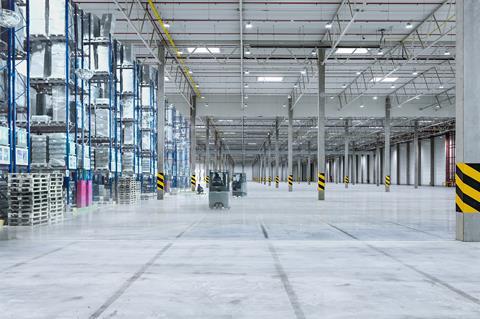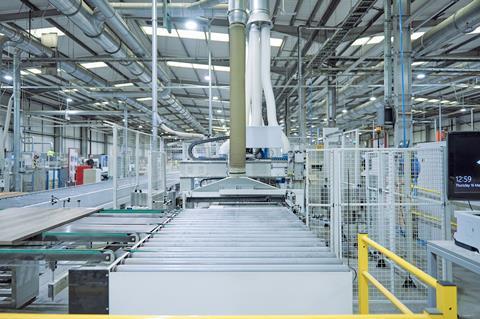The word ‘dilapidations’ means different things to different people. If you’re a landlord it can mean a big “payday”, as one senior industry figure puts it. If you’re a tenant, it can mean the exact opposite.

In layman’s terms dilapidations are the ‘exit costs’ a tenant pays at the end of their lease to ensure the building is returned to the landlord in the same condition as when it was let. The problem is in the modern day world the concept of dilapidations is no longer fit for purpose.
“When we’re talking about net carbon zero, we’re talking about the circular economy,” says Martin Heffron, a director in the building and project consultancy team at Savills. “So, you can come in and put in the most lavish fit-out and then, at the end of the lease – and sometimes that can be just three years – you’re ripping it all out, and it’s just going to end up in a skip or landfill. That’s not sustainable.”
So how can the industrial and logistics sector best tackle this issue and make the dilapidations process more sustainable?
According to Chris Earle, director in the industrial and logistics advisory team at Savills, there are a number of things that occupiers can do to green up their act.
“They might choose to look at second-hand racking to be more environmentally friendly,” says Earle. “They might look at carpets that are sourced sustainably and look at all of these procurement methods that keep that sustainability agenda right at the forefront of what they’re doing. They then occupy that property in the most environmentally sustainable way they possibly can.”
Omega Poole, a partner at Mishcon de Reya, says another “easy win would be to rent furniture, fixtures and equipment, a similar model to the one we are seeing in the residential sector with the collaboration between John Lewis and Fat Llama”.
She adds: “Landlords and tenants could also include elements within fit-outs that can be easily repaired – for example, electrical equipment whose components can be removed for repair, given how notoriously difficult electrical items are to recycle – as this will reduce waste. Better yet would be to approach each new fit-out with circular economy principles in mind.”
Instead of a distant dream, a more virtuous and sustainable future has become the new reality
Tom Saunders, Sintali
The problem is that it is not always easy to do this, because as Workman senior associate Chris Wilkins points out, a warehouse can have “such a multitude of uses and layout combinations it’s almost inevitable” that it won’t suit an incoming tenant’s requirements.
That said, he adds the “most common warehouse tenant fit-out comprises mezzanines and racking, both of which are recyclable or reusable. Indeed, there are companies that will take them away at no cost for reuse or recycling once a contractor has dismantled them”.
Wilkins advises the landlord’s surveyor to work closely with the marketing agents to “ascertain how likely it is the fit-out would be of interest to an incoming tenant; if there is scope for it to be retained, then this shouldn’t be discounted”.
Scope to reuse fit-outs
He also says that depending on why the tenant is vacating the space, there can “often be scope for them to dismantle and reuse their fit-out elsewhere”. He adds: “This is often overlooked by an outgoing tenant as the new premises is the priority and relocating fit-out would probably lead to downtime.
“Proactive engagement and establishing intentions in good time before lease end will enable both parties to explore the options fully”.
A number of more forward-thinking landlords and tenants are already following some of the guidelines set out by the likes of Wilkins.
Rob Cosslett, interim fund manager of Schroder UK Real Estate Fund, says his company looks to “use existing materials, boost cycle storage, improve external green space, harvest rainwater, and offer flexible layouts”, wherever possible.
While it is laudable that many landlords are rising to the sustainability challenge, engaging with tenants on these types of initiatives is vital, says Tom Saunders, co-founder and MD of eco-friendly consultancy Sintali. “Better tenant engagement will lead to more sustainable practices in the logistics sector, and landlords that act collaboratively with tenants will increasingly stand out.

“By being proactive, landlords can provide added value to their tenants and through positive action can inspire their tenants to achieve more in the specification of their fit-out options. Instead of some distant dream, a more virtuous and sustainable future has become the new reality.”
Which is just as well, says David Cox, a partner at Hollis, who explains that he has dealt with dilapidations claims “most of my working life and it pains me to see skips filled with furniture and materials at the end of a tenancy”.
He adds: “That said, a lot of tenants have bespoke requirements, and even though a fit-out is of great quality, it simply may not be needed by a landlord or new tenant. If left in situ, it may jeopardise the future rental of the space.
“The terms of the lease may also force the tenant to reinstate the property to the condition it was [in] at the start of the tenancy without much consideration to sustainability. If a tenant has to yield up the premises with ‘vacant possession’, there may be a risk that if items are not removed, the lease may continue for many years at considerable cost – so the risk does not facilitate a discussion between the parties.”
Cox says a small amount of engagement between the tenant and landlord early on in the process could be cost-effective for both parties and definitely more sustainable.
“Making fit-outs less bespoke would help, and the landlord may not have to ask for reinstatement at the end of the term,” he says. “Fully demountable partitions can be reused many times, as can items such as lighting and carpets. Polishing warehouse flooring would be more sustainable than painting the surface.”
‘Wholly unsustainable’ approach
While there are lots of straightforward measures that can be put in place to reduce, reuse and recycle materials commonly found in warehouses at the end of leases, at the moment the way many people in the property industry approach dilapidations is “wholly unsustainable,” according to Peter Bell, founder of the Commercial Tenants Association.
He says the “vast majority of tenants” are highly conscious of sustainability and would much prefer to be given the option to keep various fittings, which would both save them money and the planet.
And he believes that many of the dilapidations issues encountered at the end of a lease could have been addressed from the outset.
“It’s difficult for tenants and landlords to come up with solutions when they’re sitting either side of a definitive and often punitive lease,” says Bell. “Heads of terms and leases need a new approach and mandatory reinstatement to be no longer the norm. There needs to be flexibility for financial settlement and an independent surveyor’s report on condition and the sustainability credentials of tenant fixtures and fittings.”
Bell also thinks that there should be a longer period of discussion and consultation before the end of a lease to establish what installations the tenant has fitted that can be left to give more time for negotiations and independent assessment.
“Ultimately, landlords should share the burden and responsibility to make sure they’re doing the right thing and agents should be less lazy and more innovative with the disposal of fitted-out premises,” says Bell.
“We’re coming out of a global pandemic with many tenants looking to save money and so fitted-out space is already ‘vogue’ – let’s use this moment to change the mindset and drive change to a more sustainable solution.”
Encouragingly, Savills’ Heffron thinks that “collaboration and communication is happening,” and people are starting to think differently about dilapidations in light of the sustainability challenge facing not just the property sector, but the planet.
He suspects that in the future the way that landlords and tenants approach dilapidations will change and this change will be driven by younger generations, but it’s going to take time.
“For the next five years, I think things will continue as they are, sadly, if I’m really honest,” says Heffron.”But I think the next 10 years looks very different. I really do. We cannot continue like this, we absolutely cannot”.

Industrial and logistics sector abuzz with activity
- 1
- 2
- 3
- 4
- 5
- 6
- 7
- 8
 Currently reading
Currently readingOut with the new, in with the old
- 9
- 10
- 11








































No comments yet